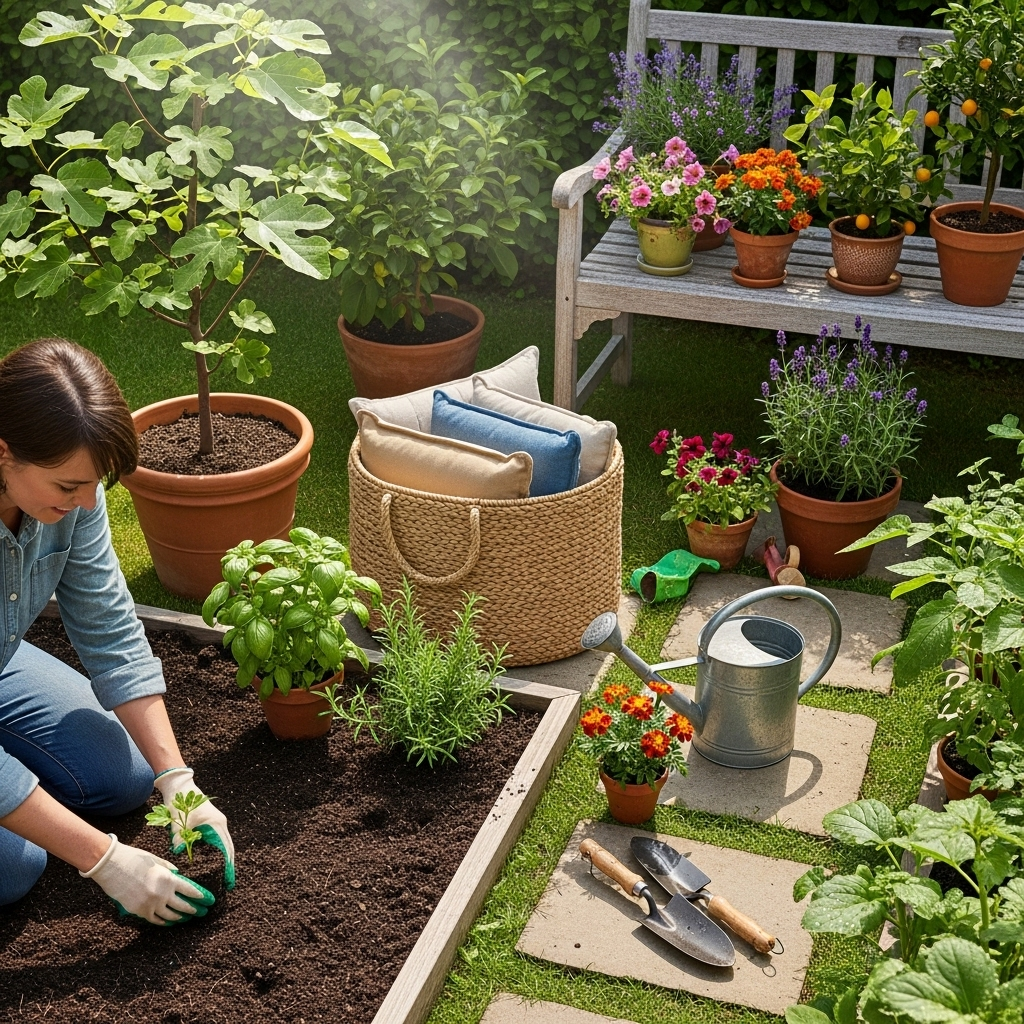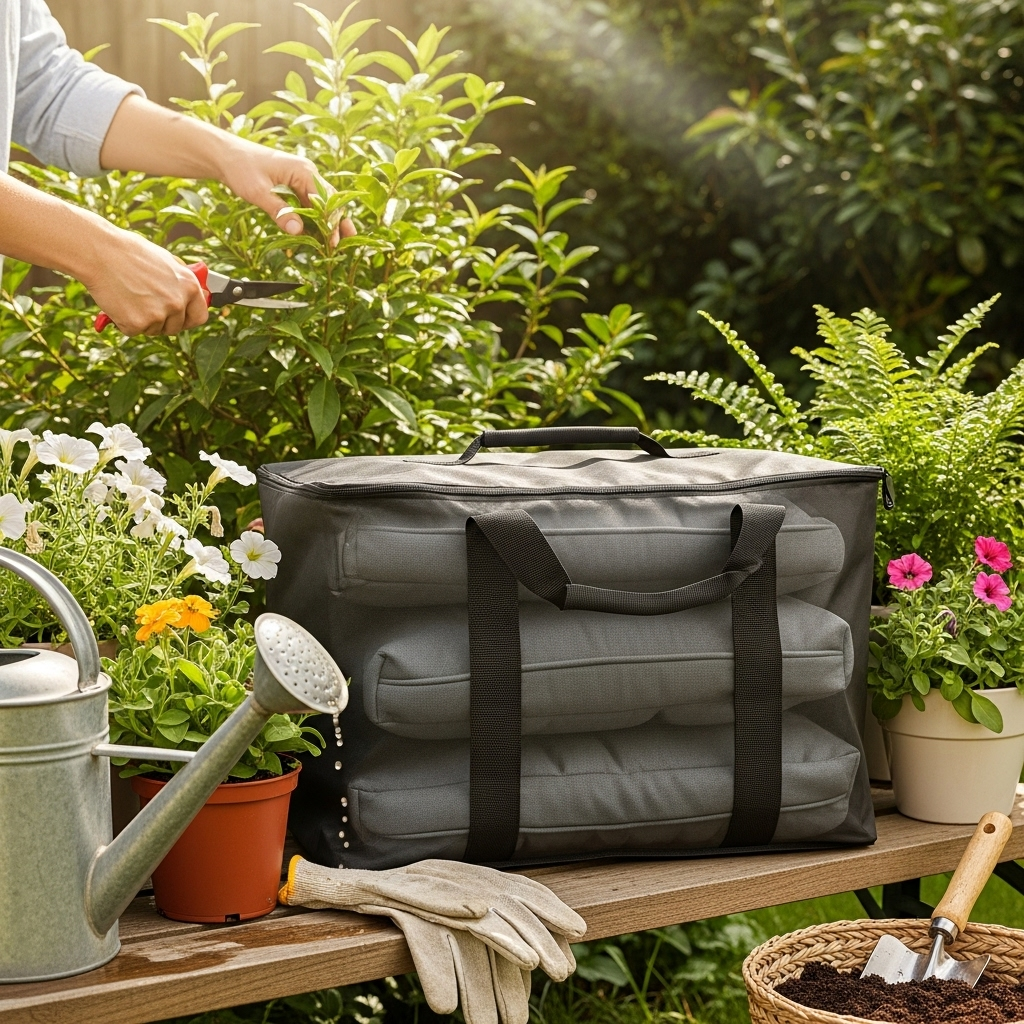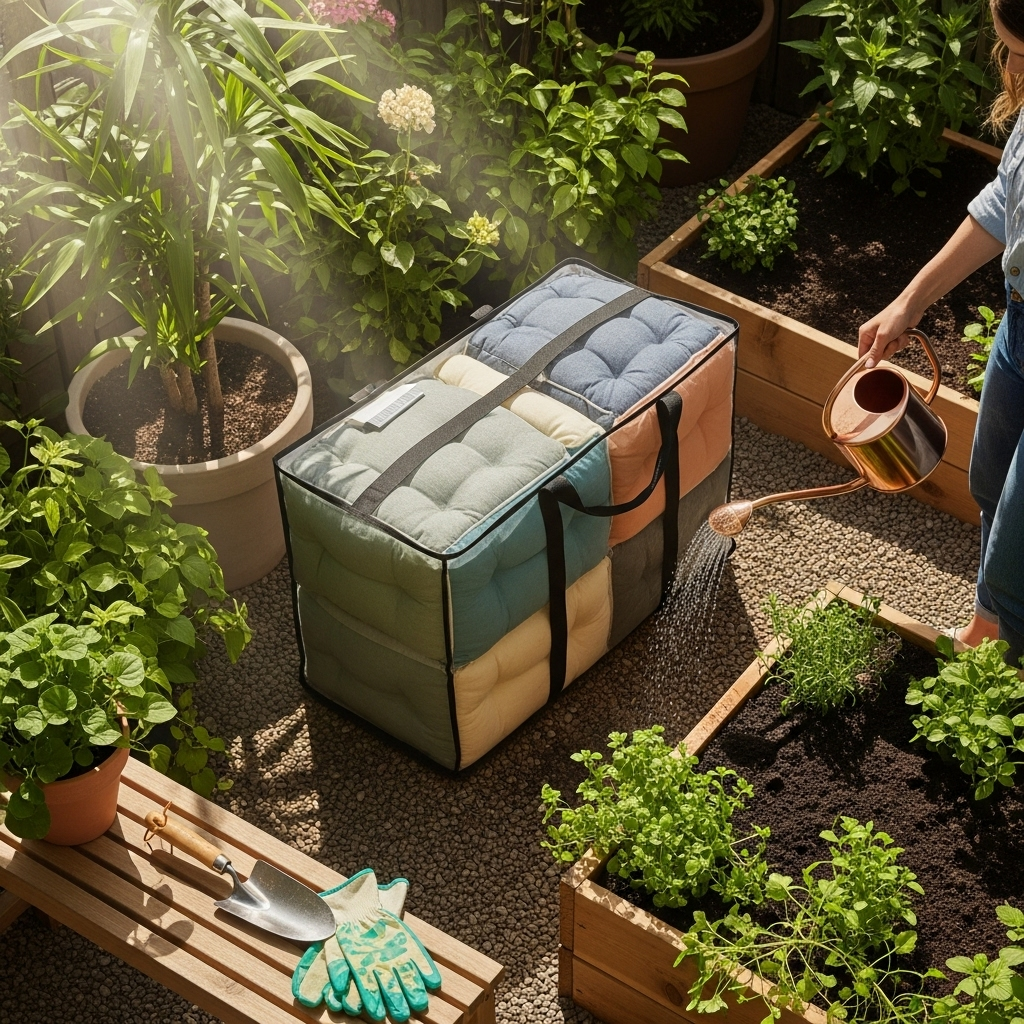Your outdoor cushions can last longer and look better with the right storage bag. A durable, waterproof storage bag protects them from rain, sun, dust, and pests, saving you money and hassle. It’s the easiest way to keep your patio’s comfort looking great season after season.
Hello green thumbs and happy homemakers!
Is there anything more delightful than sinking into a comfy outdoor cushion on a sunny afternoon? I think not! But as much as we love our patio seating, those cushions can take a beating. Rain can soak them, sun can fade them, and critters can decide they’re the perfect new nesting spot. It’s enough to make anyone sigh!
The good news is, there’s a super simple solution that can keep your cushions looking plush and vibrant for years to come. It doesn’t require complicated DIY skills or a huge budget. We’re talking about the humble, yet mighty, storage bag for outdoor cushions!
In this guide, I’ll walk you through everything you need to know to pick the perfect storage bag, how to use it effectively, and why it’s truly your patio’s best friend. Let’s get those cushions ready for their cozy slumber!
Why Outdoor Cushion Storage Bags Are a Game-Changer
Think of your outdoor cushions as little sun-worshippers and rain-catchers. They’re designed to withstand the elements, but even the toughest materials have their limits. Prolonged exposure to harsh weather can lead to a few common culprits of cushion demise:
- Water Damage: Even water-resistant cushions can eventually become saturated, leading to mold, mildew, and a musty smell that’s hard to get rid of.
- Sun Fading: UV rays are powerful! They can quickly turn vibrant colors into sad, washed-out hues, making your patio look tired.
- Dust and Grime: Wind blows dirt, pollen, leaves, and all sorts of debris. Layer upon layer, it can embed itself into the fabric, making cushions look dirty and feel rough.
- Pests: Spiders, insects, and even small rodents can find outdoor cushions to be a cozy, sheltered place to live or build nests. This is not only unhygienic but can also damage the cushions themselves.
- Tears and Rips: Exposure to the elements can make fabrics brittle. Frost, wind, and even just regular use can then lead to tears that are difficult to repair.
A good storage bag acts as a protective shield against all these woes. It’s like giving your cushions a cozy, dry, and safe haven when they’re not in use.
For more information on protecting your outdoor furniture, check out the USDA’s tips on protecting porch and patio furniture; they offer some great insights into general outdoor living space care!
Choosing the Right “Outdoor Cushion Storage Bag” for You

With so many options out there, how do you find the perfect storage bag for your precious patio pillows? It’s not just about grabbing the cheapest one you see. Let’s break down the key features to look for:
Material Matters: What to Look For
The material is the most crucial aspect of a durable storage bad. You’ll typically find bags made from:
- Polyester: A popular and generally affordable choice. Look for polyester treated with a UV-resistant coating and a water-repellent finish. Higher denier polyester (a measure of fabric thickness and density) usually indicates better durability.
- Nylon: Often stronger and more abrasion-resistant than polyester. It can be a bit pricier but offers excellent durability. Again, look for water-repellent and UV-resistant treatments.
- Heavy-Duty Vinyl/PVC: These are usually the most waterproof options. They can be a bit stiffer than fabric bags, especially in colder weather, but they offer excellent protection against moisture and dirt.
- Ripstop Materials: This refers to a weaving technique that makes fabric resistant to tearing and ripping. If you’ve had bags tear in the past, ripstop is a great feature to seek out.
Size and Shape: Think About Your Cushions!
This might seem obvious, but measuring is key! Outdoor cushions come in all sorts of shapes and sizes – from standard chair pads to large sectional sofa cushions and even oversized lounge cushions.
- Measure your cushions before you buy. Consider measuring them even when they are slightly compressed, as you’ll be packing them in.
- Measure the total volume if you plan to store multiple cushions in one bag.
- Bags often come in standard sizes like “chair cushion,” “lounge cushion,” “sectional cushion,” or simply by dimensions (e.g., 48″L x 24″W x 12″H).
- Don’t go too small: Trying to stuff cushions into a bag that’s too small can strain the seams and make it difficult to close.
- Don’t go too big: While a little extra room is okay, a bag that’s excessively large might allow moisture and pests to accumulate.
Key Features to Enhance Protection
Beyond the basic material and size, several features can make a storage bag truly excellent:
- Waterproofing/Water Resistance: This is paramount. Look for terms like “waterproof,” “water-repellent,” or “hydro-repellent.” While some bags are fully waterproof, others are highly water-resistant, meaning they can handle rain but might not be submersible.
- UV Resistance: This prevents the bag material itself from degrading under sunlight and helps protect the cushion colors inside from fading.
- Zippers: Heavy-duty, rust-proof zippers are essential for easy access and a secure closure. Consider bags with zippers that run along three sides for maximum opening.
- Handles: Sturdy, reinforced handles make it much easier to move the bag, especially if it’s heavy or contains multiple cushions.
- Venting: While you want protection from the elements, some amount of airflow can help prevent moisture buildup inside the bag, especially if cushions are stored for very long periods or in humid climates. Look for mesh vents discreetly placed.
- Reinforced Seams: Double-stitched or reinforced seams add strength, preventing the bag from splitting open, especially when fully packed.
- Full Coverage: Ensure the bag offers complete coverage, protecting all sides of the cushions.
Types of Storage Bags
Generally, you’ll find a few main types of storage bags:
| Bag Type | Description | Best For | Considerations |
|---|---|---|---|
| Individual Cushion Bags | Smaller bags designed to fit one or two standard chair cushions. | Smaller cushions, separating different types of cushions (e.g., seat vs. back). | Can be more time-consuming to store many cushions; need more storage space for the bags themselves. |
| Large Rectangular/Duffel Bags | Boxy or duffel-like bags, often with handles and full-length zippers. Available in various large sizes. | Multiple cushions, larger sectional pieces, thicker cushions. | Can become very heavy when full; ensure floor base is sturdy if storing large, heavy bags. |
| Shaped Storage Bags (e.g., for Stackable Chairs) | Bags specifically designed to fit stacked outdoor (usually dining) chairs with cushions. | Storing cushions that are part of a specifically designed chair set where they are meant to be detached and often stored together. | Less versatile if your cushions are mixed and matched. |
How to Use Your Storage Bag: Step-by-Step
Storing your cushions properly is just as important as choosing the right bag! Follow these simple steps to ensure your cushions are protected throughout their off-season:
Step 1: Clean Your Cushions Thoroughly
This is a vital step that many people overlook. Storing dirty cushions can encourage mold, mildew, and pest activity. Before you zip them up, give them a good clean:
- Brush off loose debris: Use a stiff brush to remove dirt, cobwebs, leaves, and other surface debris.
- Spot clean stains: For minor stains, use a mild soap and water solution with a soft brush or cloth. Gently scrub the stained area.
- Deeper clean (if necessary): For more stubborn stains or general grime, check the manufacturer’s care label. Many outdoor cushion covers are removable and machine washable (on a gentle cycle, cold water). If not, you can often use an upholstery cleaner specifically designed for outdoor fabrics, following the product instructions carefully. Sometimes a gentle hose-down and scrub with a mild detergent is sufficient.
- Rinse well: If you’ve used any cleaning solutions, make sure to rinse the cushions thoroughly to remove all soap residue.
Crucially, ensure cushions are completely dry before storing. Even a little dampness can lead to mold and mildew growth inside the bag.
Step 2: Ensure Cushions Are Completely Dry
This cannot be stressed enough! Even if you’ve only spot-cleaned or they’ve gotten wet from a brief shower, they need to be bone dry.
- Air dry: Lay cushions flat in a well-ventilated area, preferably in direct sunlight, for at least 24-48 hours.
- Flip and fluff: Rotate and fluff the cushions periodically to ensure all sides and stuffing dry evenly.
- Test for dampness: Feel the thickest part of the cushion. Squeeze it in your hand. If you feel any moisture or see any condensation, let them dry longer.
Storing damp cushions is a recipe for disaster – think musty smells, mold, and material breakdown.
Step 3: Compress and Fold (If Necessary)
Depending on the type of cushions and the bag you have:
- For standard, firm cushions: You might be able to place them directly into the bag.
- For softer, thicker cushions: You might be able to gently compress or fold them slightly to fit them into the bag more easily and reduce the overall volume. Be careful not to crease them sharply, as this can damage the integrity of the stuffing over time.
- Avoid excessive force: Don’t try to jam cushions into a bag that’s too small. This can stress the seams and zippers.
Step 4: Pack Cushions into the Storage Bag
Now for the main event!
- Open wide: Fully open the storage bag. If it has a large zipper, lay it flat as much as possible.
- Place cushions strategically: Start with the largest or firmest cushions at the bottom. Overlap thinner cushions where possible, or stack them neatly.
- Fill the space: Try to fill the bag as evenly as possible. This helps prevent shifting and makes the bag easier to handle.
- Handle with care: If a cushion is particularly bulky, you might need to gently guide it in.
Step 5: Seal the Bag Securely
Once all your cushions are comfortably nestled inside:
- Close the zipper: Slowly and carefully zip the bag shut. Make sure no fabric gets caught in the zipper. If the zipper sticks, gently pull the fabric away and try again.
- Secure any closures: Some bags might have Velcro flaps or buckle straps in addition to zippers. Secure these to keep the zipper protected and the bag sealed.
Step 6: Store the Bag Properly
Where you store the bag matters!
- Ideal location: The best place is a dry, well-ventilated area like a garage, shed, or basement.
- Elevate if possible: If you’re concerned about potential floor moisture (especially in garages or sheds), consider placing the bag on a shelf, a pallet, or even an old piece of lumber.
- Avoid direct sunlight: Even though the bag is designed for outdoor cushions, storing the bag itself in direct, intense sunlight can degrade the bag material over time and significantly increase the internal temperature, which isn’t good for the cushions.
- Keep away from pests: Ensure the storage area is free of rodents and insects.
Benefits of Using a “Storage Bag for Outdoor Cushions”

Let’s recap why investing in these bags is such a smart move:
- Extended Lifespan: The most significant benefit! Protecting cushions from unnecessary wear and tear means they’ll last many seasons longer.
- Cost Savings: Fewer replacements mean more money in your pocket for gardening supplies or, you know, more fun patio stuff!
- Maintained Appearance: Keep colors bright and fabrics looking new. Your patio will always be ready for guests.
- Improved Hygiene: Prevent mold, mildew, and dust buildup for a cleaner, healthier outdoor space.
- Pest Prevention: Keep unwanted visitors from making a home in your cushions.
- Ease of Storage: Neatly organized cushions take up less space and are easier to find and retrieve when the season starts again.
- Protection During Winter Months: Essential for those living in climates with harsh winters where snow, ice, and freezing temperatures can wreak havoc.
Potential Downsides and How to Mitigate Them
While mostly beneficial, no solution is perfect. Here are a few potential drawbacks and how to work around them:
| Potential Downside | Mitigation Strategy |
|---|---|
| Cost of Bags: High-quality bags can be an investment. | Look for sales, consider purchasing in bundles if you have many cushions, or invest in one good quality bag that will last for years rather than several cheap ones. Prioritize durability over the lowest price. |
| Storage Space: Even in bags, cushions take up room. | If space is very limited, consider cushions that can be more easily compressed or flatter cushion styles. Organize your storage area efficiently. |
| Moisture Trapping: If not fully dry or if the bag isn’t breathable enough, moisture can get trapped. | Ensure cushions are 100% dry before storing. Choose bags with some form of subtle ventilation if storing in very humid areas or for extended periods. Check bags periodically. |
| Zipper Issues: Zippers can snag, break, or corrode over time. | Opt for bags with robust, rust-resistant zippers. Be gentle when zipping and offer the zipper some protection from the elements if stored outside. |
Alternatives to Dedicated Storage Bags

While a dedicated storage bag is often the best solution, if you find yourself needing a temporary fix or if budget is a major concern, here are a few alternatives:
- Large Tarp and Bungee Cords: You can fold cushions together, place them on a raised surface (like wooden pallets), and cover them tightly with a heavy-duty tarp, securing it with bungee cords. This offers decent protection but is less neat and may not be fully waterproof if not done meticulously.
- Plastic Storage Bins: Large, heavy-duty plastic bins with tight-fitting lids can work. Ensure they are completely dry inside and out. This is best for flatter cushions and requires careful stacking to avoid crushing.
- Old Blankets/Comforters + Plastic Sheeting: For very short-term or less critical storage, you could wrap cushions in old blankets for padding and then cover them thoroughly with heavy-duty plastic sheeting, taping it securely. This is the least durable option and really only suitable for very brief periods indoors.
However, it’s worth noting that these alternatives often don’t offer the same level of dedicated protection, ease of use, or long-term durability as a purpose-designed storage bag. For protecting your investment in comfortable outdoor seating, a proper bag is hard to beat!
Frequently Asked Questions (FAQ)
Q1: How do I know if my outdoor cushions are dry enough to store?
A: Feel the thickest part of the cushion. Squeeze it. If you detect any moisture, dampness, or see condensation, they are not dry enough. It’s best to let them air dry in the sun for at least 24-48 hours, flipping them periodically. When in doubt, let them dry longer!
Q2: Can I store my outdoor cushions outdoors in their storage bags?
A: While the bags protect from rain and sun, storing them outside, even in a bag, is generally not recommended for long-term storage (like over winter). The best practice is to store them in a dry indoor location like a garage, shed, or basement. If you absolutely must store them outside, place them on elevated, covered platforms and choose the most heavy-duty, waterproof bag available, but be aware this still shortens their lifespan compared to indoor storage.
Q3: What’s the best way to store outdoor cushion covers if they are removable?
A: If your cushion covers are removable and washable, you can wash and dry them thoroughly, then fold them neatly and store them in a smaller storage bag or within the cushion storage bag itself. Storing just the covers separately can help prevent stuffing from getting musty if the stuffing itself is prone to issues.
Q4: My storage bag smells musty. What should I do?
A: This usually means moisture was trapped inside. First, take the cushions out. Air out both the cushions and the bag in direct sunlight for a day or two. If the smell persists, clean the cushions again. For the bag itself, you can wipe it down with a mild disinfectant or a vinegar-water solution (rinse and dry thoroughly). Consider adding a desiccant packet inside the bag for future storage.
Q5: Will a storage bag protect my cushions from animals?
A: A sturdy, well-sealed storage bag offers good protection from most common pests like spiders and insects. However, determined rodents (like mice or rats) might chew through weaker materials. For maximum protection against determined critters, opt for bags made from thicker, ripstop materials and store them in a secure indoor location.
Q6: How many cushions can I fit in a large storage bag?
A: This depends entirely on the size of the bag and the size and type of your cushions. A “large” bag might fit 4-6 standard chair seat cushions, or 2-3 larger back cushions, or even some elements of a sectional. Always check the dimensions of the bag and compare it to the dimensions and thickness of your cushions. It’s better to have slightly too much room than not enough.
Conclusion

Caring for your outdoor cushions doesn’t have to be a chore. By investing in a good quality storage bag and following a few simple steps for cleaning and storing, you can ensure your patio seating remains comfortable, attractive, and ready for every season. A storage bag for outdoor cushions is more than just a cover; it’s an investment in the longevity and beauty of your outdoor living space. Happy storing, and here’s to many more seasons of comfortable outdoor relaxation!
